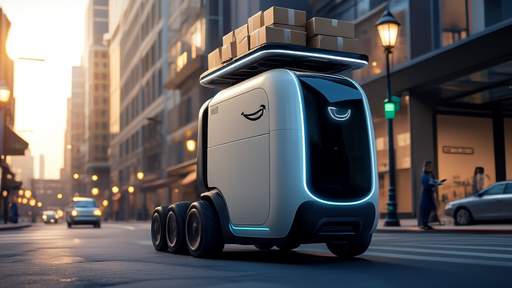In the rapidly evolving world of e-commerce, Amazon has always been at the forefront of innovation. Its latest endeavor, testing humanoid robots for package delivery, could potentially revolutionize the logistics industry and redefine the role of human couriers.
Amazon's Robotics Program: A Step Forward
Amazon is currently accelerating its robotics program with an ambitious plan to test humanoid robots that could one day deliver packages to customers' doorsteps。This initiative is part of Amazon's broader strategy to automate the "last mile" of delivery, which is often the most challenging and costly part of the logistics chain. To achieve this, Amazon has established a specialized training center known as the "humanoid park" in San Francisco. This indoor obstacle course is designed to simulate real-world delivery scenarios, including navigating through doorways, climbing stairs, and even interacting with obstacles like pets and children.
The Testing Phase and Technological Challenges
The testing phase is crucial for Amazon to determine the feasibility and effectiveness of humanoid robots in delivery roles. The company is reportedly working with multiple robotics manufacturers, including Unitree from China, which provides a $16,000 humanoid robot. These robots will be tested for their ability to handle various package weights and dimensions, as well as their navigation skills in complex environments.
However, there are still significant technological challenges to overcome. For instance, robots need to be able to adapt to unpredictable situations, such as dealing with adverse weather conditions or unexpected obstacles. Additionally, ensuring the robots can interact safely and effectively with humans, especially at the point of delivery, is another critical aspect that requires extensive testing.
Implications for Human Couriers
The potential replacement of human couriers with robots raises important questions about employment and the future of work. Amazon currently employs hundreds of thousands of delivery workers worldwide. While the company has not explicitly stated that it plans to replace human couriers entirely, the development of delivery robots suggests a significant shift towards automation.
On one hand, robots offer several advantages: they do not require rest, benefits, or overtime pay, making them an attractive alternative for performing repetitive and physically demanding tasks. On the other hand, the transition to robotic delivery could lead to job losses in the logistics sector. However, it is also possible that new job opportunities may emerge in areas such as robot maintenance, software development, and logistics management.
Broader Industry Impact
Amazon's move towards robotic delivery is likely to have a ripple effect across the entire logistics industry. As a market leader, Amazon's adoption of new technologies often sets the trend for other companies. If Amazon successfully integrates humanoid robots into its delivery operations, it could prompt other logistics companies to invest in similar technologies to remain competitive.
Moreover, the integration of autonomous vehicles and humanoid robots could lead to the creation of fully automated logistics networks. This would not only increase efficiency and speed but also reduce costs significantly. However, widespread adoption of such technologies would require addressing regulatory, safety, and ethical concerns.
The Future Outlook
As Amazon continues to test and refine its robotic delivery systems, the future of logistics looks increasingly automated. The successful deployment of humanoid robots could lead to faster and more reliable deliveries, potentially transforming the customer experience.
However, the transition to robotic delivery is not without its challenges. Technological advancements need to be balanced with social and economic considerations. Amazon's investment in robotics testing suggests that radical changes to the delivery process are on the horizon.
Amazon's exploration of humanoid robots for package delivery represents a bold step towards a more automated future. While the full implications of this shift are yet to be seen, it is clear that the logistics industry is on the cusp of a significant transformation.

By Christopher Harris/Jun 6, 2025

By Emily Johnson/Jun 6, 2025

By Laura Wilson/Jun 6, 2025

By Jessica Lee/Jun 6, 2025

By William Miller/Jun 6, 2025

By Victoria Gonzalez/Jun 6, 2025

By /May 21, 2025

By /May 21, 2025

By /May 21, 2025

By /May 21, 2025

By /May 21, 2025

By John Smith/May 19, 2025

By Sophia Lewis/May 19, 2025

By Christopher Harris/May 19, 2025

By Natalie Campbell/May 19, 2025

By Grace Cox/May 19, 2025

By Amanda Phillips/May 19, 2025

By Megan Clark/May 19, 2025

By Eric Ward/May 19, 2025

By Ryan Martin/May 19, 2025